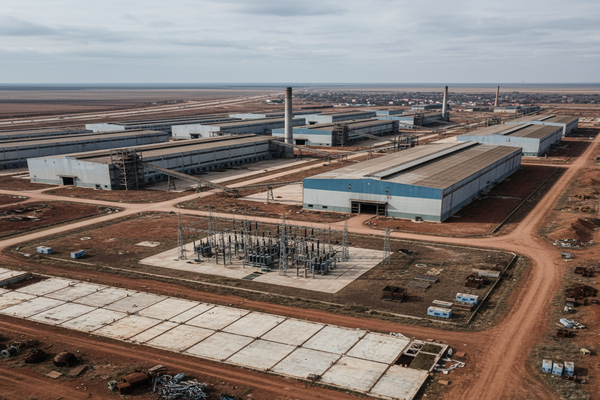
US auto industry is installing more battery capacity than it needs. Automakers sped up plant builds during the EV boom and now face falling demand and policy changes that are slowing or halting projects. Ford NYSE:F delayed phases of a major Tennessee site that once promised 6,000 jobs. That matters now because recent policy moves by the US administration and cooling consumer interest are combining to create immediate supply gluts and near-term revenue pressure. In the short term the oversupply is driving margin compression and project delays in the Battery Belt. Over the long term excess capacity could spur consolidation or lower battery costs globally, affecting markets in the US, Europe, Asia and emerging economies.
How excess battery capacity shapes the trading day
Immediate market pressures and sector sentiment.
Stocks tied to vehicle electrification are likely to open under pressure as investors parse project delays and policy shifts. Automakers that expanded battery and EV commitments during the boom now face softer demand and paused expansions. The most direct impact falls on suppliers and local contractors that had priced in steady ramp ups. The pause in facility activations is reducing near-term capital spending and weighing on industrial orders. Investors will watch production guidance from listed suppliers and any comments from large automakers for signs of margin stress later in earnings cycles.
Macro traders will also factor in the spillover to broader sentiment. A string of project delays in the US heartland signals weaker equipment orders and slower hiring in manufacturing hubs. That effect can show up in industrial sector ETFs, regional bank exposure and small cap names that rely on construction and new hires. European and Asian markets may react as well because lower battery demand in the US can reduce component exports and change cross-border trade flows.
Policy shifts and investor reaction
Regulatory changes alter incentive math and capital plans.
Recent changes in national policy are reshaping the calculus for where and how companies invest. Measures that affect tax credits, procurement or immigration influence the cost and speed of building battery plants. That is why project timelines have shifted in places such as Stanton, Tennessee where a Ford NYSE:F joint venture facility has seen repeated delays. Traders will be sensitive to any new guidance from policy makers about subsidies and procurement rules because even modest adjustments change the return on capital for factories that take years to fill.
Markets will price reassessments of long term forecasts into valuations. In the short run investors will weigh the likelihood of further project pauses and the potential for write downs or slower hiring. In the longer run policy clarity could encourage a reset in capital allocation that either firms up surviving projects or accelerates consolidation among suppliers. Commentary from policy makers or industry groups could swing sector sentiment during the session.
Regional economies face immediate strain
Battery Belt communities confront slower growth and hiring delays.
The Battery Belt stretching from Georgia to Indiana had attracted large commitments and construction schedules built on rising EV sales. Now those communities are seeing quieter job postings and deferred phases. Stanton, Tennessee once expected 6,000 new workers at a joint venture battery plant. With phased rollouts delayed, local suppliers and service firms face lower revenue and slower hiring that can weigh on local banks and tax receipts.
Traders should watch regional data releases and municipal bond spreads for signs of stress. Slower local growth also matters to consumer demand in these areas which can feed back into auto sales. Global investors will watch to see if other countries step in with incentives that could reallocate some investment offshore. That potential reallocation could influence currencies and trade sensitive sectors during the trading day.
Historical context and what it means for markets
From boom to rebalancing: how today compares with prior cycles.
The rapid build out of battery plants echoed past infrastructure surges that later required consolidation. Historically, industries with heavy upfront investment and long lead times experience cycles of overcapacity followed by mergers and output rationalization. The current situation mirrors those patterns. Initially aggressive capacity additions met optimistic demand projections. Now demand growth is slower than expected and policy changes have shortened timelines for returns. Markets will watch earnings and capacity utilization metrics for signs that firms are moving from construction to optimization.
This rebalancing can create winners and losers. Firms that can shift capacity, secure long term offtake agreements, or reduce costs will be viewed more favorably. Others may face margin pressure and asset impairments. Traders should pay attention to commentary on utilization rates and capital expenditure revisions. Those updates will be central to pricing adjustments across autos, materials and industrial supply chains during the session.
Near-term indicators traders should track in the session
Data points and headlines that could steer market moves.
Expect volatility around headlines about project delays, policy clarifications or corporate guidance revisions. Earnings statements that revise volume forecasts or capex plans will be especially relevant. Regional labor reports and construction data can add color about the pace of hiring tied to plant builds. International trade figures and export orders from Asia and Europe will show whether demand is shifting globally or if the US is absorbing most of the slowdown.
Market participants should also watch credit spreads for regional borrowers and vendor receivables that could widen as projects pause. While the immediate session will focus on headline news flow and any corporate updates, the larger story is an industry pivot from fast expansion to capacity management. That transition will influence relative performance across sectors and inform risk sentiment for the coming weeks.
Today’s session will likely price in both the near-term pain of delayed projects and the longer-term implications of excess capacity. Traders will respond to fresh data and commentary that clarify who bears the costs and how fast rebalancing will progress. The market impact will not be limited to the auto sector. It will extend to suppliers, regional economies and to overseas producers that compete in battery components. Expect a news-driven trading day where headlines about policy, project timelines and utilization figures set the tone.












